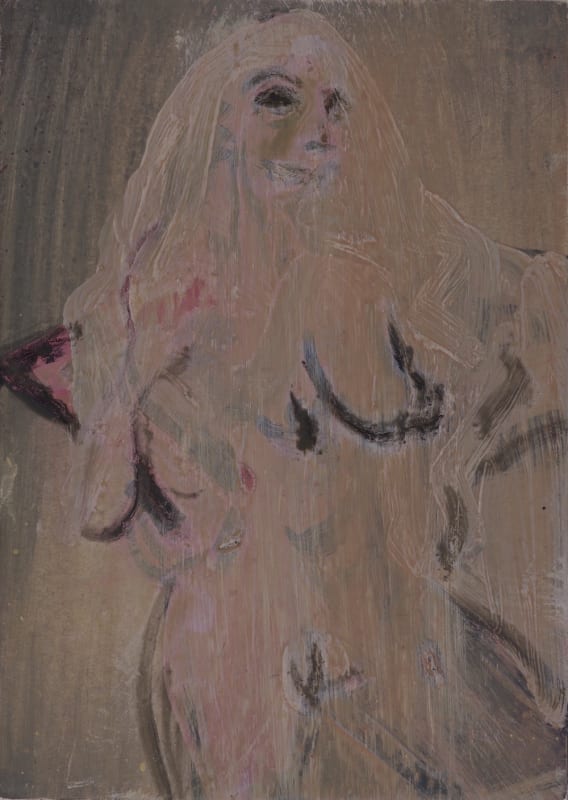Private view: 16th November 6:30-9 pm
We live in a world of opposites – contrasting and complementing forces, the pushes and pulls of hard and soft, the structured and the organic, real and imagined, masculine and feminine. The group exhibition Body (17 November – 21 December) at Kristin Hjellegjerde, brings together the works of six female artists whose practices examine these paradigms, celebrating the joyous and messy, the secrecy and intimacy of our relationships with each other, and with ourselves. Materials, thoughts and private and communal histories are juxtaposed to raise questions about sexuality and relationships, probe established norms and the intimate worlds that exist within each of us.
Maha Ahmed explores the identity of self in consequence of the other. Growing up in the context of Pakistan, where concealing is seen as a way of self-preservation, Ahmed uses nature as a portrait. In works such as a bird meandering in a lucid dream, she seeks to unravel the line between space and object, creating fluidity within assumed realities. Her work questions the formation of collective narratives that stem from gender, race and religious beliefs. She builds fictional spaces that are reminiscent of natural forms to confront the validity of presumed truths. By using the dry brush technique that originated from the illuminated manuscripts of Persia, she calls on the familiar but caveats it with a contemporary twist.
In Annie Attridge’s playful porcelain series, should of could of would of, we are presented with scenes and snippets of shapes and forms of imagined or real lustful trysts the artist should have done, could have done, would have done, or even might have done. A continued loved affair with porcelain plays out through erotic imagery, using avatars and the female form to describe the symbiosis of sexual and romantic consciousness, of love and conflict. Geometrically structured bases are placed under each sculpture, reminiscent of wobbly scaffolding, but still strong at the core. The sculptures and bases then balance on top of the organically constructed concrete plinths to create towers of, or to love, romantic hedonist ideals presented ‘on a pedestal’.
The female form, sexuality and desire are also at the centre of Anna Ilsley’s colourful, figurative works. Her paintings and drawings probe the confusion of arcane ideals of female chastity, sin and sexiness in contemporary culture. Her series, The Wedding Album, for example, illustrates both her fascination and terror of the expectations surrounding such an occasion, and the juxtaposition between idealism and failure within such a traditional pretext of feminine beauty and image. She attempts to disrupt sweeping hypocrisies towards the female form by exposing the nuances of female experience, championing the embarrassing, cocky, sensual, funny and self-conscious, channelling her ongoing frustration with the way women are still presented to us as available bodies for consumption, whether that is through porn, fashion, advertising or beyond.
Relationships between bodies are key, and the diptych shown in Body by Katja Larsson very literally places two objects in relation to one another, in this case, the masculine/feminine play of a Jesmonite cast of a Kawasaki body and a piece of petrified wood cast in pink flesh-coloured silicone. She examines the interplay between what we read as ‘nature’ and ‘culture’ and which materials/objects belong along this axis, as well as references to classical sculpture. The forms of her objects emit an inherent movement, and reference exoskeletons and bone structures, with a nod to anthropomorphism. They are ultimately displayed as museum artefacts, on metal stands, fantasy remnants from an imagined past in an imagined future.
Different materials are also at the heart of Héloïse Delègue’s practice. Her paintings and constructed textiles incorporate symbols, objects, fabrics and paint to question human relationships and hierarchies within genders. Using the view of an anthropologist, she uses memories, which she combines with myths and factual truths to comment on current societal, cultural and political narratives. By observing networks of people around her in displacement and transitions she looks at new forms of relationships in a context where belief systems and values seem to be disrupted, conflicted, and challenged by new forms of digital communications.
Moving more into the realm of the abstract are the pastel-hued works of Rachel Garrard, using a pigment derived from powdered rock collected by the artist from the remote Andean peaks of South America. After your glow evokes the softness of dawn light, abstracting the complex human anatomy into simplified forms. Reticular compositions are mapped to the dimensions of her body, the compositions reduced to a few coloured planes, the complexity of which lies within the specific meeting of points and the spaces between. The interplay between geometric lines and shapes and the soft, fleshy colours creates a liminal space in which personal experience and ideas of transcendence collide.







